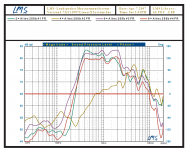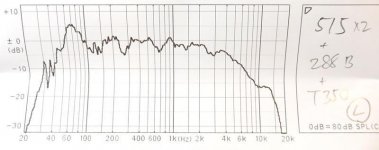No other benefit??
My actual statement is right there in post 391. I'm not sure why you removed the modal verb.
They have huge benefits over most horns
I'm genuinely curious to know what they are.
That is: what, if anything, does a vintage style DIY multicell do better than a modern multiple entry constant directivity horn (of equivalent size and coverage angle).
Basically, I'd be interested in the 803b vs. SH50 comparison that you refer to.
I'm not sure why the OP thought he could cross the horns lower than about 450, but that's not a fault of the horn. You need the right horn and the right driver to cross low.
The OP noted this in post 12.
Not everybody had a cache of vintage / $$ equipment to rotate through, or access to reasonably cheap, used US equipment.
Dry fitting the front spacers. You can see that I did not glue the cells together perfectly. Luckily, the plastic is soft enough not to matter much. 9 cells printed, 6 more to go.
The front spacers make the mouth pretty stiff. I hope the casting will also make the walls stiff enough. Stil not decided on the material, casting with liquid silicone sealant seems to be a good option now.
The front spacers make the mouth pretty stiff. I hope the casting will also make the walls stiff enough. Stil not decided on the material, casting with liquid silicone sealant seems to be a good option now.
Attachments
Yes, they are capable of making sound beyond 2kHz. But the OP stated they had odd artifacts when he tried a higher crossover, and 2kHz is what he went with.
OK, I can only assume that he couldn't make the cell throat adapter to the incredibly low tolerance of the original's thin sheet tin construction.
No longer have a copy and the web link is dead, but the cell throats were sanded? to a fine knife sharp taper, or at least the pioneer's were, and wouldn't surprise me if jeweler level craftsmen made them.
Regardless, the more cells the more cross talk between them, so need to be pretty far away or put them behind a screen to damp them. Another is the need for heavy damping between cells, though with wood construction, probably not necessary since thicker than the tin ones, which in at least some of the DIY ones obviously have wider cell spacing, increasing cross talk.
In short, I was talking design theory, well documented history, so yeah, seems reasonable that even well done wood replicas wouldn't perform up high as well, though if one can sit > ~ 25 ft away...........
GM has answered this. Better polar patterns then single cell horns. Sectoral horns and those with vanes approach the favorable patterns of the multi-cell.I'm genuinely curious to know what they are.
The better polar pattern is easy to hear, and not difficult to see in basic measurements.
Probably better polar response, at least in their bandwidth. I've seen only one mention of a balloon measurement of a multi-cell and when I contacted the owner, the file had been lost. A good on paper comparison is going to be difficult to some by, until someone funds a 3D or balloon measurement.That is: what, if anything, does a vintage style DIY multicell do better than a modern multiple entry constant directivity horn (of equivalent size and coverage angle).
It never happened. I changed jobs and had to move to an island 8000 kilometers away. The A5 multi-cell system did not go with me. It would have been a comparison between a Synergy and a 1005 horn on the 828 cabinet, tho, not the 803 horn. The Synergy horns are very good, most of them, and are certainly worth a listen. I'd be very happy with a pair at home or at work, but it's not in the budget.Basically, I'd be interested in the 803b vs. SH50 comparison that you refer to.
I certainly don't have a cache of $$ vintage equipment. Or much of anything, really. My entire system cost less than some people pay for a pair of "entry level" speakers or even speaker cables.Not everybody had a cache of vintage / $$ equipment to rotate through, or access to reasonably cheap, used US equipment.
Have you had the chance to hear a system with multi-cell horns? Have you heard the Danley SH50 or SH69?
No longer have a copy and the web link is dead, but the cell throats were sanded? to a fine knife sharp taper, or at least the pioneer's were
Post 4 "the cells have zero edge width at their beginning".
The pictures show that they were sanded down until they were ~paper thin.
Regardless, the more cells the more cross talk between them, so need to be pretty far away or put them behind a screen to damp them.
[...] though if one can sit > ~ 25 ft away...........
Which could explain why, for home use, their optimum bandwidth seems to be more limited than their cinema / ampitheatre bandwidth.
Haste makes waste!  That's what I get for just scanning the little pics.
That's what I get for just scanning the little pics. 
That said, I forgot to mention the few originals I've seen up close is that as they get near the throat they become a conical round horn to ~ match up with the throat adapter, short conical horn built into the driver.
I assumed as much, but wanted to expand as much as [my] knowledge allows [or can remember] for folks to know as much as possible about the finer points of successful horn/speaker design as too often I've been exposed to really pi$$ poor builds, both for sale and DIY, not to mention some of my early attempts that were only good for learning what not to do.
That said, I forgot to mention the few originals I've seen up close is that as they get near the throat they become a conical round horn to ~ match up with the throat adapter, short conical horn built into the driver.
I assumed as much, but wanted to expand as much as [my] knowledge allows [or can remember] for folks to know as much as possible about the finer points of successful horn/speaker design as too often I've been exposed to really pi$$ poor builds, both for sale and DIY, not to mention some of my early attempts that were only good for learning what not to do.
The better polar pattern is easy to hear, and not difficult to see in basic measurements.
In the only measurements I have seen, the pattern control is not spectacular.
This pdf shows the polars for a large multicell (figure 33).
https://content.instructables.com/ORIG/F4B/RZ72/JQ6YFXNZ/F4BRZ72JQ6YFXNZ.pdf
The figure applies to this EV horn, which is a metre across. There's one of these horns currently on ebay for a thousand $US.
http://mypicsonline.net/archive/archives.telex.com/archives/EV/Horns/EDS/M253 EDS.pdf
Comparing that to the coverage pattern of a fairly conventional, widely copied horn, the JBL 2380:
https://jblpro.com/en-US/site_elements/2380a-data-sheet
...the huge EV has horizontal control to a lower frequency, but the pattern is less even - and the JBL has better vertical control, to a lower frequency.
If you compare the metre-wide multicell to a modern horn that's similarly large (the K402), the modern horn seems to have better polars - and you can clone the K402 with a lot less effort.
The spec sheet for that EV horn shows that the lobing "fingering" pattern begins at 3kHz. This seems consistent with the HF artefacts that Petter described; (on a Swedish site, that I can no longer find) he talked about his multicell horn sounding odd if crossed at 3.5 or 4kHz.
The Synergy horns are very good, most of them, and are certainly worth a listen. I'd be very happy with a pair at home or at work, but it's not in the budget.
That's the impression I get - and they seem to be a lot less effort to DIY.
I've heard nothing like the metre wide EV's that I linked. I doubt many of these multicell rigs made it to Australia.Have you had the chance to hear a system with multi-cell horns? Have you heard the Danley SH50 or SH69?
I've heard some of the "sectoral horns with vanes" - I bought some myself (brand unknown, probably of UK or local manufacture; they look like mildly improved copies of the Altec 800 horn), and I've heard what appeared to be a gently tweaked Altec A7 rig in Japan - it was playing at modest levels and sounded pleasant; it was clear and nothing about it called attention to itself, which I consider a good thing.
There are a few Danley type systems locally, and I've heard a couple. 24 Moons is a venue that has good sound with them - easy to like at high SPL (
IMO, most similar venues to have steely / nasty HF at high SPL).
The systems I've heard are probably all copies rather than imports, e.g. made by Red Spade.
I once made a rough multiple entry horn prototype, and was pleasantly surprised with how easy it was to set up. The first combo I tried, built with scraps, worked just fine.
Post 2 here: pattern control below 400Hz
I forgot to mention the few originals I've seen up close is that as they get near the throat they become a conical round horn to ~ match up with the throat adapter, short conical horn built into the driver.
...and this seems like a feature where 3D printing could "win".
You could simplify all this plumbing by printing the driver's phase plug and the multicell origins as one piece, rather than having the soundpath go through multiple bolted-together bits (driver slots --> adapter --> horn slots).
Still not decided on the material, casting with liquid silicone sealant seems to be a good option now.
Hi,
you remember that silicone sealants are rather heavy (and expensive for that amount, too)? I'd consider polyurethane foam rather than silicone that hasn't got any air bubbles within.
GM has answered this. Better polar patterns then single cell horns. Sectoral horns and those with vanes approach the favorable patterns of the multi-cell.
The better polar pattern is easy to hear, and not difficult to see in basic measurements.
I feel that my question is answered finally. Thank you!
Best regards!
I've never seen a multi-cell where the cell throats where anything other than square, like the cells themselves. I've put some thought into rectangular cell throats, but they come with their own problems. 3D printing of the throat adapter to the cells ought to allow for some clever designs that could ease the transition from round exit compression driver to a group of square cells.
A few years back I designed a small multi-cell for the Altec coax that used a set of hexagons around two pentagons for tight cell coupling. Think of a football (soccer). It was supposed to be 3D printed, but never happened.
For me, it basically comes down to experience. I've been listening to and working with multi-cell horns since about 1983. During that time many other horns have caught my ear and my interest. Smith, exponential, conical, Keele, Iwata, Tractrix, mixed mode and others. But for me, the multis keep out-performing them all in real listening tests. That has lead me to give up on anything else, it's just not worth my time and effort when I can get what I want from the mulit-cell horns.
A few years back I designed a small multi-cell for the Altec coax that used a set of hexagons around two pentagons for tight cell coupling. Think of a football (soccer). It was supposed to be 3D printed, but never happened.
For me, it basically comes down to experience. I've been listening to and working with multi-cell horns since about 1983. During that time many other horns have caught my ear and my interest. Smith, exponential, conical, Keele, Iwata, Tractrix, mixed mode and others. But for me, the multis keep out-performing them all in real listening tests. That has lead me to give up on anything else, it's just not worth my time and effort when I can get what I want from the mulit-cell horns.
Here are some graphs;
OBJ's ( over at LHF ) old 288B's were mounted onto 1005 multicells ( if I recall correctly ).
- One can see that example #2 had a surround that was suffering from a case of extreme "work-hardening" ( or something similar ) .

This interesting pic is lifted from a french forum ( a 288B on a 1505 ).
- I have a hard time believing the T350 was actually working.

One can see ( hopefully ? ) that the spreading of the HF energy into large quantities of individual cells creates the need for some sort of Constant Directivity "like" compensation .

OBJ's ( over at LHF ) old 288B's were mounted onto 1005 multicells ( if I recall correctly ).
- One can see that example #2 had a surround that was suffering from a case of extreme "work-hardening" ( or something similar ) .
This interesting pic is lifted from a french forum ( a 288B on a 1505 ).
- I have a hard time believing the T350 was actually working.
One can see ( hopefully ? ) that the spreading of the HF energy into large quantities of individual cells creates the need for some sort of Constant Directivity "like" compensation .
Attachments
Last edited:
1-That extreme LF loss with a HF peak would likely result from a frozen diaphragm, from a shifted pole piece or top plate, or a chunk of debris or corrosion stuck in the gap.1- One can see that example #2 had a surround that was suffering from a case of extreme "work-hardening" ( or something similar ) .
2- This interesting pic is lifted from a french forum ( a 288B on a 1505 ).
I have a hard time believing the T350 was actually working.
3-One can see ( hopefully ? ) that the spreading of the HF energy into large quantities of individual cells creates the need for some sort of Constant Directivity "like" compensation .
2- The T350 has about 104 dB sensitivity at the top end, the 288B mid-band more like 115, so the little top end shelf may be the tweeter response- or not, impossible to say from the chart if the tweeter was in phase (adding SPL) or blocking the HF response of the 1505's center cell. The EV-T series diaphragm alignment and depth is particularly sensitive to error, which can result in huge (-3 to-10dB) sensitivity losses.
3- Yes, though the HF EQ boost won't change the HF cell "fingering", if the 1005 was measured "on-axis", the amount of HF compensation may be less than the chart would suggest.
Art
I've never seen a multi-cell where the cell throats where anything other than square, like the cells themselves.
Yeah, at the time I posted, all that I could remember in detail was some with round throats, but in retrospect thinking it was some Jensen 'K' series multi-cells, though the main thing was it sounded better overall than my then ex-cinema 805 tar filled, which I don't recall ever taking apart except at the drivers to have them refurbished, i.e. my not fixing what ain't broke mentality at the time.
GM,
You might be remembering these;






You might be remembering these;
Attachments
-
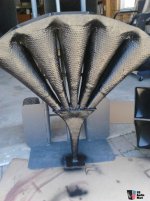 2480241-c2989d21-8-or-10-cell-250hz-large-multicell-horns-pairs-for-altec-tad-jbl-1-14-2.jpg81.6 KB · Views: 666
2480241-c2989d21-8-or-10-cell-250hz-large-multicell-horns-pairs-for-altec-tad-jbl-1-14-2.jpg81.6 KB · Views: 666 -
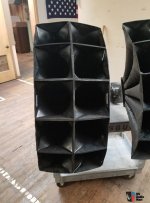 2480243-1e6c65db-8-or-10-cell-250hz-large-multicell-horns-pairs-for-altec-tad-jbl-1-14-2.jpg57 KB · Views: 682
2480243-1e6c65db-8-or-10-cell-250hz-large-multicell-horns-pairs-for-altec-tad-jbl-1-14-2.jpg57 KB · Views: 682 -
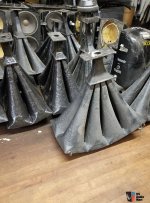 2480244-ce6ddf07-8-or-10-cell-250hz-large-multicell-horns-pairs-for-altec-tad-jbl-1-14-2.jpg93.9 KB · Views: 644
2480244-ce6ddf07-8-or-10-cell-250hz-large-multicell-horns-pairs-for-altec-tad-jbl-1-14-2.jpg93.9 KB · Views: 644 -
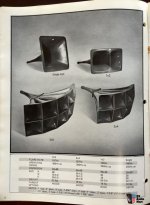 2480246-bb4be95e-8-or-10-cell-250hz-large-multicell-horns-pairs-for-altec-tad-jbl-1-14-2.jpg62.8 KB · Views: 643
2480246-bb4be95e-8-or-10-cell-250hz-large-multicell-horns-pairs-for-altec-tad-jbl-1-14-2.jpg62.8 KB · Views: 643 -
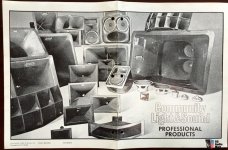 2480245-ab475d30-8-or-10-cell-250hz-large-multicell-horns-pairs-for-altec-tad-jbl-1-14-2.jpg113.9 KB · Views: 628
2480245-ab475d30-8-or-10-cell-250hz-large-multicell-horns-pairs-for-altec-tad-jbl-1-14-2.jpg113.9 KB · Views: 628
Yes Earl, I thought of those horns when GM mentioned round. I've never seen those in person and have wondered what they did at the cell entrance. If the are round then it leaves a lot of gap between each cell. I'd love to see and hear those.
I have yet to hear the "fingering" that I read so much about. I've listened for it and asked every visitor to my listening room to tell me if they hear it, even up close. So far, no one has. Certainly the cells will start to beam at some frequency, but maybe it's high enough that it just isn't a worry.
I had to do a high shelf on the 803 and the 1005 horns with Radian or Altec 288 drivers. But I expected to, just like any horn. The nice thing about the multi-cell is that HF energy gets spread around fairly evenly with not a lot of beaming.3- Yes, though the HF EQ boost won't change the HF cell "fingering", if the 1005 was measured "on-axis", the amount of HF compensation may be less than the chart would suggest.
I have yet to hear the "fingering" that I read so much about. I've listened for it and asked every visitor to my listening room to tell me if they hear it, even up close. So far, no one has. Certainly the cells will start to beam at some frequency, but maybe it's high enough that it just isn't a worry.
You might be remembering these
No, pretty sure they were Jensen 32 cell in retrospect and use to have quite a few pics on line, but Google no longer takes me where I want to go.
TTBOMK I've only seen CS multi-cells in catalogs; if there was ever any in metro Atlanta, the Altec distributor where I got ~ 99% of my general prosound knowledge wasn't aware.
Anyway, the combiner/resonator design is the overall key, the round Vs rectangular is minor IF they have the same throat area [St] and from dim memory the Jensen's round throats extended well into the cavity to come together as one with solder to fill the tiny gaps.
Last edited:
I have yet to hear the "fingering" that I read so much about. I've listened for it and asked every visitor to my listening room to tell me if they hear it, even up close. So far, no one has. Certainly the cells will start to beam at some frequency, but maybe it's high enough that it just isn't a worry.
Based on CTC spacing, so the more cells, the lower it extends, but by the same token, a plurality of eigenmodes will at some point be summed as a single coherent pressure wave by our hearing.
I like to visualize it as a horizontal and vertical fine mesh 'screen' overlaid on the horn's actual output and as long as one is on axis and no early first reflections there's a perception of finer detail resolution, depth than with a single cell, but in a typical HIFI/HT app the shifting of this overlay relative to the pressure wave can make it seem a bit 'phasy' IME [fingering? Don't recall this moniker].
In short, even in my original ~26 x 46 ft, half cathedral ceiling room, the 805s needed to go PDQ and since there were no 1803 I lusted after available, shifted to large baffled, tweaked 511/802, then stacked 511 and finally an 1803 tar filled sized Olson conical horn w/dual 802 that ended my search till Tom told me about his new time/phase coherent multiple driver horn invention in a PM, so if I ever should make another horn system [highly doubtful at this point
- Home
- Loudspeakers
- Multi-Way
- The construction of a multicell horn
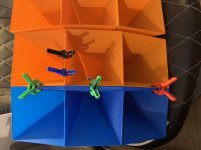
 !
!